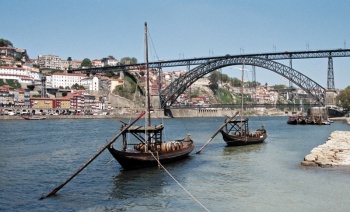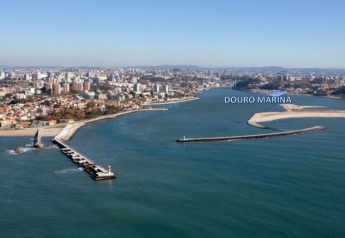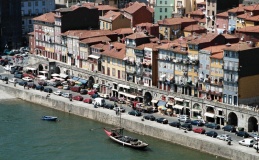Porto
From CruisersWiki
m (bot: Berthing) |
Istioploos (Talk | contribs) (Move Routes) |
||
| Line 2: | Line 2: | ||
{{TOC block}} | {{TOC block}} | ||
{{Infobox |41|8.35|N|08|36.92|W| | {{Infobox |41|8.35|N|08|36.92|W| | ||
| + | | portofentry= y | ||
| zoom= 13 | | zoom= 13 | ||
| image= PortoWaterfront.jpg | | image= PortoWaterfront.jpg | ||
| imagetext= Porto old town | | imagetext= Porto old town | ||
| + | | notes= <googlemap lat="41.145311" lon="-8.66272" zoom="13" width="352" scale="yes"></googlemap> | ||
}} | }} | ||
| - | |||
| - | |||
| - | |||
| - | |||
| - | |||
The historic city of Porto (also known as Oporto) is the second largest in [[Portugal]] after [[Lisbon]]. Situated on the west coast at the mouth of the river Douro, the city’s wealth of attractions and beautiful setting won it World Heritage Site status in 1996. Porto’s most famous export is the fortified wine produced from the vineyards lining the upper reaches of the river, which takes its name, port, from the place of production and bottling. Many of the famous port lodges still survive on the south bank of the river in the suburb of Vila Nova de Gaia. Until 2012 visiting yachts had the option of mooring in the grimy harbour of [[Leixoes]] on the coast five miles NW of the city centre or taking their chances alongside in the river. With the opening of the new [[Douro Marina]] in the estuary of the river, however, a visit to Porto is now much easier and more secure. | The historic city of Porto (also known as Oporto) is the second largest in [[Portugal]] after [[Lisbon]]. Situated on the west coast at the mouth of the river Douro, the city’s wealth of attractions and beautiful setting won it World Heritage Site status in 1996. Porto’s most famous export is the fortified wine produced from the vineyards lining the upper reaches of the river, which takes its name, port, from the place of production and bottling. Many of the famous port lodges still survive on the south bank of the river in the suburb of Vila Nova de Gaia. Until 2012 visiting yachts had the option of mooring in the grimy harbour of [[Leixoes]] on the coast five miles NW of the city centre or taking their chances alongside in the river. With the opening of the new [[Douro Marina]] in the estuary of the river, however, a visit to Porto is now much easier and more secure. | ||
| - | |||
| - | |||
| - | |||
==Charts== | ==Charts== | ||
| Line 28: | Line 22: | ||
: C19 | : C19 | ||
| - | == | + | ==Weather== |
| - | + | ''See [[Portugal#Weather|Portugal]]''. | |
| - | + | ||
| - | '' | + | ==Passages== |
| + | ''See [[Portugal#Passages|Portugal]]''. | ||
==Navigation== | ==Navigation== | ||
| Line 40: | Line 34: | ||
As with most harbours along this coast, there can be an uncomfortable swell at the entrance in strong winds and the breakwaters should be given a wide berth. | As with most harbours along this coast, there can be an uncomfortable swell at the entrance in strong winds and the breakwaters should be given a wide berth. | ||
| + | |||
| + | ==Communication== | ||
| + | * | ||
| + | * | ||
| + | |||
| + | ''Also see [[World MM Nets|World Cruiser's Nets]]''. | ||
| + | |||
==Entrance== | ==Entrance== | ||
[[Porto]] is a port of entry/exit to [[Portugal]]. | [[Porto]] is a port of entry/exit to [[Portugal]]. | ||
| - | + | ''For entrance details see [[Portugal#Entrance|Portugal]]''. | |
==Berthing== | ==Berthing== | ||
| - | + | * | |
===Marinas & Yacht Clubs=== | ===Marinas & Yacht Clubs=== | ||
* [[Douro Marina]] | * [[Douro Marina]] | ||
| Line 69: | Line 70: | ||
The city of [[Porto]] is the second largest in Portugal and one of the country's most historic, a status which won it recognition in 1996 as a World Heritage Site. Among its numerous attractions are the old fishermen's quarter of Ribeira on the north bank of the Douro river, a maze of narrow streets and old houses with colourful facades. From here one can walk across the Dom Luis I bridge (which has fabulous views over the river) to the district of Vila Nova De Gaia, renowned as the centre of the port wine industry. Several of the port houses here do regular tours for visitors, for which advance booking might be required at busy periods. Some of the well-known port houses still maintain their traditional ''barcos rabelos'' boats, which were once used to transport wine down the Douro river to their cellars. Among the city's architectural attractions are the magnificent Baroque church of Sao Francisco, with its amazingly ornate gilded wood interior, and the almost equally impressive Renaissance church of Santa Clara near Porto's monumental 12th century cathedral (also worth a visit). To relax after a day's frantic sightseeing, walk up through the old town to the gardens of the Palacio Cristal, which is a lovely and peaceful spot to enjoy the evening sun. Hidden at one corner of the gardens is the delightful Solar do Vinho do Porto, a tasting centre with over 100 different ports to sample. Try a glass or three of the delicious Fonseca Scirocco Extra Dry on its sunlit terrace. | The city of [[Porto]] is the second largest in Portugal and one of the country's most historic, a status which won it recognition in 1996 as a World Heritage Site. Among its numerous attractions are the old fishermen's quarter of Ribeira on the north bank of the Douro river, a maze of narrow streets and old houses with colourful facades. From here one can walk across the Dom Luis I bridge (which has fabulous views over the river) to the district of Vila Nova De Gaia, renowned as the centre of the port wine industry. Several of the port houses here do regular tours for visitors, for which advance booking might be required at busy periods. Some of the well-known port houses still maintain their traditional ''barcos rabelos'' boats, which were once used to transport wine down the Douro river to their cellars. Among the city's architectural attractions are the magnificent Baroque church of Sao Francisco, with its amazingly ornate gilded wood interior, and the almost equally impressive Renaissance church of Santa Clara near Porto's monumental 12th century cathedral (also worth a visit). To relax after a day's frantic sightseeing, walk up through the old town to the gardens of the Palacio Cristal, which is a lovely and peaceful spot to enjoy the evening sun. Hidden at one corner of the gardens is the delightful Solar do Vinho do Porto, a tasting centre with over 100 different ports to sample. Try a glass or three of the delicious Fonseca Scirocco Extra Dry on its sunlit terrace. | ||
| - | + | {{hgallery2|Porto tourism| | |
| - | + | {{himage|Ribeira.jpg|Ribeira district, [[Porto]]}} | |
| - | + | {{himage|Rabelos.jpg|Traditional barco rabelo at Vila Nova da Gaia}} | |
| - | + | {{himage|Flora.jpg|Flower among the flowers, Porto}} | |
| - | + | }} | |
====Grocery & Supply Stores==== | ====Grocery & Supply Stores==== | ||
| Line 98: | Line 99: | ||
* Metro system | * Metro system | ||
* Bus and tram network | * Bus and tram network | ||
| - | |||
| - | |||
| - | |||
==Friends== | ==Friends== | ||
| Line 118: | Line 116: | ||
{{Comments}} | {{Comments}} | ||
| - | |||
* | * | ||
{{Verified by}} | {{Verified by}} | ||
| - | |||
* | * | ||
Revision as of 18:19, 25 May 2016
| Porto Port of Entry
| |
The historic city of Porto (also known as Oporto) is the second largest in Portugal after Lisbon. Situated on the west coast at the mouth of the river Douro, the city’s wealth of attractions and beautiful setting won it World Heritage Site status in 1996. Porto’s most famous export is the fortified wine produced from the vineyards lining the upper reaches of the river, which takes its name, port, from the place of production and bottling. Many of the famous port lodges still survive on the south bank of the river in the suburb of Vila Nova de Gaia. Until 2012 visiting yachts had the option of mooring in the grimy harbour of Leixoes on the coast five miles NW of the city centre or taking their chances alongside in the river. With the opening of the new Douro Marina in the estuary of the river, however, a visit to Porto is now much easier and more secure.
Charts
- British Admiralty charts
- 3633
- 3634
- 3254
- Portuguese charts
- 23201
- 24201
- 26401
- Imray chart
- C19
Weather
See Portugal.
Passages
See Portugal.
Coming from the north, the huge oil refinery of Petrogal Refinaria do Norte is conspicuous, two miles before the harbour of Leixoes. The entrance to the Douro river is a further two miles SSE, protected on the N side by a long breakwater the end of which is marked with a light structure with red and white bands. From the south, a yacht will pass along a detached breakwater protecting the river entrance from W (staying at least 100 metres off until arriving at the entrance) before turning to starboard inside the N breakwater. From the entrance there is a channel marked with two starboard and two port buoys and with average depths of 5.0 metres up to the entrance to Douro Marina on the S bank.
As with most harbours along this coast, there can be an uncomfortable swell at the entrance in strong winds and the breakwaters should be given a wide berth.
Communication
Also see World Cruiser's Nets.
Entrance
Porto is a port of entry/exit to Portugal.
For entrance details see Portugal.
Berthing
Marinas & Yacht Clubs
Anchorages
In the city centre on the North bank of the river you can berth at the quay 'Cais da Estuva'. When mooring mind the tidal difference of about 2 to 2.5 meters. Please moor as far downstream of this small quay as it is also used by ferries to embarque en desembarque passengers. Anchoring in the river is forbidden.
Yacht Repairs and Services
Marine Stores
See entry for Douro Marina.
Repairs/Yards
See entry for Douro Marina.
Fuel, Water, & Electricity
See entry for Douro Marina.
Things to do Ashore
Tourism
The city of Porto is the second largest in Portugal and one of the country's most historic, a status which won it recognition in 1996 as a World Heritage Site. Among its numerous attractions are the old fishermen's quarter of Ribeira on the north bank of the Douro river, a maze of narrow streets and old houses with colourful facades. From here one can walk across the Dom Luis I bridge (which has fabulous views over the river) to the district of Vila Nova De Gaia, renowned as the centre of the port wine industry. Several of the port houses here do regular tours for visitors, for which advance booking might be required at busy periods. Some of the well-known port houses still maintain their traditional barcos rabelos boats, which were once used to transport wine down the Douro river to their cellars. Among the city's architectural attractions are the magnificent Baroque church of Sao Francisco, with its amazingly ornate gilded wood interior, and the almost equally impressive Renaissance church of Santa Clara near Porto's monumental 12th century cathedral (also worth a visit). To relax after a day's frantic sightseeing, walk up through the old town to the gardens of the Palacio Cristal, which is a lovely and peaceful spot to enjoy the evening sun. Hidden at one corner of the gardens is the delightful Solar do Vinho do Porto, a tasting centre with over 100 different ports to sample. Try a glass or three of the delicious Fonseca Scirocco Extra Dry on its sunlit terrace.
Grocery & Supply Stores
Eateries
Internet/WiFi
In Douro Marina.
Laundry
Motorbike & Car Rentals
Numerous rental outlets in the city.
Garbage Disposal
Bins in the marina.
Transportation
- Airport of Francisco de Sá Carneiro (15 km to the NW)
- Trains to local and international destinations
- Metro system
- Bus and tram network
Friends
Contact details of "Cruiser's Friends" that can be contacted for local information or assistance.
Forums
List links to discussion threads on partnering forums. (see link for requirements)
Links
- Porto at the Wikipedia
References & Publications
See Portugal.
Comments
We welcome users' contributions to the Wiki. Please click on Comments to view other users' comments, add your own personal experiences or recommend any changes to this page following your visit.
Verified by
Date of member's last visit to Porto and this page's details validated:
| This page has an outline in place but needs completing. Please contribute if you can to help it grow further. Click on Comments to suggest further content or alternatively, if you feel confident to edit this page, click on the edit tab at the top and enter your changes directly. |
| |
|---|
|
Names: Haiqu, Athene of Lymington |




